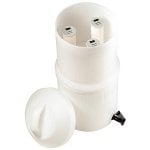Around this time last month we talked about the outbreak of cholera in Haiti and a whole lot of our readers started to wonder if such an epidemic could ever reach the States… and we answered ‘yes’, but we don’t believe it would get much traction due to this country’s water quality infrastructure.
The disease ran rampant, and continues to run rampant across Haiti because the country’s sanitation system, or more accurately because of its LACK of a decent sanitation system. Without a way to properly process (disinfect/sanitize) human waste, the vessel by which cholera and many other diseases spread, that waste can easily find its way into water supplies where it has the opportunity to infect many more people.
Sounds nasty, but that grim story has existed as a harsh reality for the residents of Haiti and other areas we in the United States and other ‘Western’ countries have labeled as ‘Third World’.
The disease was originally endemic to the Indian subcontinent, particularly around the Ganges river. Trade routes by land and sea helped spread it to Russia, then to western Europe, then America during the Irish immigration period. Cholera is no longer considered a pressing health threat in Europe and North America due to filtering and chlorination of water supplies, but still heavily affects developing countries. ( source )
Stopping the spread of cholera and other diseases
Several people have come forward and blamed the Haitian government and a number of emergency relief agencies for not having enough medicines and vaccines to properly treat those who have already contracted chlorera. We think those people’s words have some merit, but not much.
The real problem lies with Haiti’s inferior sanitation and clean water distribution system. The disease normally spreads through contaminated drinking water so… instead of treating the problem after-the-fact, action needs to get taken on the front end where initial contamination occurs — and that means stopping the flow of infection waste into the water supply.
Advanced water purification and sewage systems mean the developed world no longer faces a major threat from cholera. The disposal and sterilisation of anything that may be infected is an important way of stopping its spread. ( source )
We do not have all the answers
Now before anyone gets on their high horse and asks, “Well do you know how to stop the flow of infectious waste into the Third World’s water supply?” No… No, we do not. We do know, however, that the answer lies in clean water because fewer people getting infected will, in the end, mean fewer people having the ability to spread the disease.
Since digging up all of Haiti or any other Third World country and installing proper sanitation systems would cost far more than anyone would want to pay, we suspect the solution will have to come from making safe, clean drinking water available to the masses.
Simplicity… a beautiful thing
In a country like Haiti where power lines may or may not reach many areas and the power may or may not always flow through the lines if they do exist, obviously more complex, powered water purification systems such as ultraviolet disinfection (which require power) could prove useless at the times when people might need them most.
About a month ago we talked about a series of gravity feed filters made by Doulton that use special ceramic filters to remove/reduce levels of potentially harmful Cysts (i.e. Cryptosporidium, Giardia, etc.), Particulates (i.e. Rust & Sediment Creating Turbidity), and Bacteria (i.e. E. Cholera, E. Coli, Typhoid, Shigella, Klebsiella Terrigena, etc.).
Today we’d like to offer a different gravity ceramic filter system for your consideration. This one, the Katadyn Ceradyn Drip Water Filter System uses three Katadyn ceramic depth filters remove bacteria, cysts, algae, protozoa, sediment, dirt, spores, some viruses, and other disease causing agents… down to the 0.2 micron level.
Made from BPA-free plastic and capable of producing roughly 1 gallon of filtered water per hour, Katadyn claims each Katadyn Ceradyn Drip Water Filter System has a life expectancy of 40,000 gallons.
What does that mean in the real world? Quite simply, it means that a household or village could set up a Katadyn Ceradyn Drip Water Filter System and continually feed it source water for a period of roughly 4 1/2 years and get one gallon of vastly improved drinking water each and every hour during that time.
Within that time period the individual three advanced Katadyn ceramic depth filters (20743) in the Katadyn Ceradyn Drip Water Filter System will need replacing every 13,000 gallons. But still… If used non-stop, that equals more than 500 days of continuous clean water production without need to change a filter!






